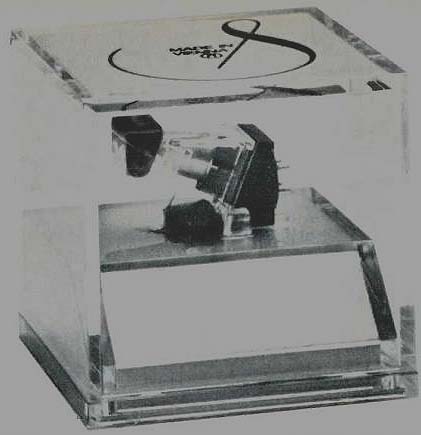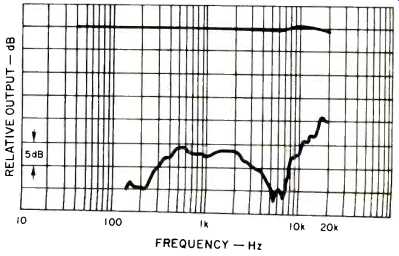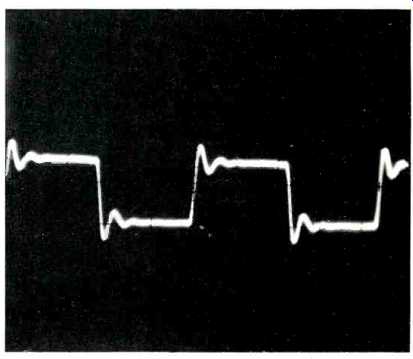
MANUFACTURER'S SPECIFICATIONS:
Stylus Description: Elliptical, 0.2 x 0.7 mil tip radius, and 0.42 mg effective mass.
Frequency Response: 10-28,000 Hz, measured using B&K QR-2010.
Output Voltage at 5 cm/sec: 3.75 mV.
Tracking Force Range: 0.75 to 1.25 grams.
Optimum Tracking Force: 1.0 gram.
Compliance: 35 x 10^-6 cm/dyne.
Channel Separation at 1 kHz: 35 dB.
Channel Separation at 10 kHz: 25 dB.
Channel Balance: Within 2 dB.
Frequency IM Distortion at -6 dB: 0.5 percent or less.
Impedance: 860 ohms and 280 mH.
Optimum Load: 47,000 ohms and 470 pF.
Weight: 5.86 grams.
Replacement Stylus Assembly: X8S (elliptical tip).
Price: $135.00.
When the name AKG ( Vienna, Austria) is mentioned, one automatically thinks of high-class professional microphones of world renown. Today, among other products, AKG manufactures a line of stereo phono cartridges, all using the variable reluctance principle. These cartridges utilize a patented transversal suspension (TS) for the stylus cantilever which is centered symmetrically in a small hole in a very thin, gold-plated metal plate. The plate and the gold-plated soft iron armature are connected to each other by a rubber element which is vulcanized to both metal parts by a special process, resulting in a knife-edge bearing of incredibly small size. The knife-edge pivot is claimed to suppress torsional and axial movement so that no spurious signals are generated. Due to the design's complete symmetry, the same mechanical conditions exist for transverse excitation in all directions. The large permanent magnet with high flux density in the air gap is not a part of the moving stylus assembly, thus reducing the effective mass of the stylus.
The overall appearance of the line of cartridges is similar, with the model P8ES being at the top of the line. The cartridge comes packed in a plastic cube. The necessary hardware is located in the bottom of the cube and included a screwdriver in the model we tested, the AKG P8ES. Also included is an individual response curve for the cartridge and directions for mounting the cartridge.
The shape of the cartridge bottom is such that it must be absolutely parallel to the record to avoid rubbing the record surface, particularly on warped records. Although the supplied wedge is meant to be used to mount the cartridge in a record-changer arm, we found that it may have to be used in a single-play tone arm if the arm cannot be adjusted so the bottom of the cartridge does not rub the record surface.
Measurements
As is our practice, measurements are made on both channels, but only the left channel is reported. During the test period the average temperature was 75° F ± 1° (23.33° C) and the relative humidity 65 percent ± 3 percent.
Frequency response, using the Columbia STR-100 test record and our reference tonearm, an Audio-Technica AT-1009, mounted on a Technics SP-10 turntable, is flat within a -0.5 dB from 40 Hz to 6 kHz, then starts to slowly rise to +2 dB at 10 kHz, finally descending to-1 dB at 20 kHz. The optimum tracking force for the cartridge we tested was at its maximum recommended tracking force, 1.25 grams. The optimum anti-skating force was 2.0 grams. Separation was superb, being 21.5 dB at 1 kHz, 37 dB at 5.6 kHz, 28 dB at 10 kHz, and 19 dB at 20 kHz. The load resistance was 47 kilohms and 470 pF capacitance. Square-wave response shows a single cycle of overshoot, but no ringing. This cartridge has one of the lowest IM distortions we ever measured.

Fig. 1 --Frequency response.
The following test records were used in making the reported measurements: Technics SFC-TR100; Micro-Acoustics TT-2002; Shure TTR-103, TTR-109, TTR-110, TTR-115; Columbia STR-100, STR-112, SQT-1100; JVC TRS-1007; Stereo Review SR-12; Deutsches HiFi No. 2, and the Nippon Columbia Audio Technical Record (PCM) XL-7004.
Wt. 5.95 g; d.c. res. 970 ohms; ind. 320 mH; opt. tracking force 1.25 g; opt. anti-skating force 2.0 g; output 0.68 mV/cm/ sec; IM distortion (4:1) + 9 dB lateral, 200/4000: 1.1%, + 6 dB vertical, 200/4000: 1.3%; crosstalk (using Shure TTR-109)-35 dB; ch. bal. 0.75 dB; trackability: high freq. (10.8 kHz pulsed) 30 cm/sec, mid-freq. (1000 + 1500 Hz, lat. cut) 31.5 cm/sec, low freq. (400 + 4000 Hz, lat. cut) 24 cm/sec; Deutsches HiFi No. 2, 300-Hz test band tracked cleanly to 86 microns (0.0086 cm) lateral and 55.4 microns (0.00554 cm) vertical. This is extremely good and very few cartridges can track these bands. The arm-cartridge resonance curve showed a resonance peak at 6 Hz with an amplitude of 7.5 dB. Although the peak resonance frequency is a little low with the Audio-Technica AT-1009 arm, we could not detect any adverse effects during the listening period.
The Micro-Acoustics Test Record TT-2002 was used to check the tracking and transient ability. The AKG P8ES cartridge encountered no difficulty in playing all the tracking ability bands. The percussion levels check the cartridge for both vertical and lateral tracking ability. The transient ability of the P8ES is excellent since the computer-generated high, low, and high/low mixed frequencies presented no problem to this cartridge.

Fig. 2 --Response to 1-kHz square wave.
The P8ES performed superbly on all bands of the Shure Audio Obstacle Course Era Ill (TTR-110). With the newer Shure Audio Obstacle Course Era IV (TTR-115) test record, the tracking ability of the P8ES did not quite pass level 5 (+12 dB above the reference level) of the flute and flute-bell test.
These are one of the most severe high-frequency trackability tests to be found and very few cartridges will track beyond level 4 of this test for it is truly an "obstacle course." In general, the results clearly point out the excellence of the transient and tracking ability of the AKG P8ES phono cartridge. In this aspect, the PEES does not have to take second place to any other cartridge known to us.
Listening Evaluation
Our listening tests are performed both prior to actually testing the cartridge parameters and again after all tests have been completed. The equipment used for the listening evaluation is identical to that used in the report last month. When we first heard some of our records played with the AKG P8ES cartridge, we were surprised by the transparency of the sound and it was probably due to the low IM distortion of the cartridge. The P8ES has excellent sonic clarity and bass response. We did not notice any high frequency effects from the 2 dB peak at 10 kHz. The P8ES did not appear to introduce either a sound of its own or coloration.
In conclusion, the AKG P8ES had no difficulty playing the listed or any other record in our collection. It is a cartridge which plays cleanly and one of the best in terms of tracking ability. Our conclusion is that the P8ES ranks among the top cartridges with very few others being its equal.
-B. V. Pisha
Reference Recordings:
A rigorous listening evaluation was conducted utilizing the specific records listed below as well as many of the records listed in past reports. These excellent recordings demonstrate quite effectively the ability of the P8ES to reproduce difficult as well as high level recordings, such as the high velocities present on many of the direct-to-disc recordings, without adding anything of its own to the music. The AKG P8ES is especially superb in reproducing the singing voice, having a clarity-and naturalness that is seldom found.
Direct to Disc
Tchaikovsky: Capriccio italien, op. 45; Rimsky-Korsakov: Capriccio espagnol, op. 34, The Boston Pops, Fiedler --Crystal Clear CCS 7003.
Creation: Super Rock at the Highest Voltage -- Toshiba-EMI LF 95016.
J. Fukamachi: Sgt. Pepper's Lonely Hearts Club Band --Toshiba-EMI LF-95014.
E. Kitamura: 30 Years in 30 Minutes--Toshiba-EMI LF-95012.
(These Toshiba-EMI discs are distributed by Audio-Technica.) Bill Berry & Ellington All-Stars: For Duke -- M&K Sound RT --101 (M&K Sound Corp., 8719 Wilshire Blvd., Beverly Hills, Calif. 90211.)
Spectrum: Direct Flight--Direct-Disk DD-104. (Direct-Disk Labs, 16 Music Circle Sound, Nashville, Tenn. 37203.)
Pulse Code Modulation (Digital, PCM, Stereo)
B. H. Soran-Bushi: Billy Harper--Denon YX-7522-ND.
Bach: Organ Concert, K. Vad --Denon OX-7048-ND.
Mussorgsky: Pictures at an Exhibition; Ravel: Pavane pour une infante defunte,Tokyo Metropolitan Symphony Orchestra, Fremaux --Denon OX-7072-ND. (These Denon PCM records are distributed through American Audioport dealers.)
Stereo
Beethoven: Symphony No. 3 in E-flat Major ("Eroica'), Chicago Symphony Orchestra, Solti --London CS 7049.
Beethoven: Missa Solemnis, Chicago Symphony Orchestra and Chorus, Solti -- London OSA 12111.
Bruckner: Te Deum; Mass No. 2 in E minor, Vienna Philharmonic Orchestra, Mehta--London OS 26506.
Floyd Cramer: Looking for Mr. Goodbar--RCA APL 1-2644.
Bartok: Violin Concerto No. 2, Kyung-wha Chung, violin, London Philharmonic Orchestra, Solti --London CS 7023.
Wagner: Meistersinger (Act 1); Tristan (Prelude), Chicago Symphony Orchestra, Solti -- London CS 7078.
Pavarotti: Bravo Pavarotti! His Great American Triumphs-- London PAV-2001-2.
Music for Percussion, Vol. 1, Tristan Fry Percussion Ensemble, Gardiner --Gale GMFD1-76-004. (This excellent recording, distributed by Audio-Technica through their dealers, rivals the better PCM and direct-to-disc records).
Check Up Your Sounds, Vol. 1, Audio Symphony--RCA ( Japan) RVL-1. (Also distributed through Audio-Technica, this highly recommended record should be owned by every audiophile to evaluate their system).
Quadraphonic-SQ
Enoch Light & Light Brigade: New Recordings of the Big Band Hits of the 30s, 40s, and 50s--Project Three PR2-6005/6 Q.
Donizetti: Gemma diVergy, Caballe --Columbia M3-34575.
Annie, Original Cast Recording--Columbia PS-34712.
(Source: Audio magazine; Dec. 1978)
Also see:
AKG P25MD/24 Phono Cartridge (Aug. 1982)
JVC Model QL-7 Direct-Drive Turntable (Dec. 1978)
Shure V15 Type V Phono Cartridge (Nov. 1982)
Signet TK10ML moving-magnet phono cartridge (Feb. 1985)
= = = =